Lithium-Ion Battery Market
Lithium-Ion Battery Market Size and Share Forecast Outlook 2025 to 2035
Lithium-ion battery market is projected to grow from USD 73.0 billion in 2025 to USD 467.7 billion by 2035, at a CAGR of 20.4%. Lithium Cobalt Oxide will dominate with a 30.5% market share, while consumer electronics will lead the application segment with a 31.0% share.
Lithium-Ion Battery Market Forecast and Outlook 2025 to 2035
The global lithium-ion battery market is projected to reach USD 467.7 billion by 2035, recording an absolute increase of USD 394.7 billion over the forecast period. The market is valued at USD 73.0 billion in 2025 and is set to rise at a CAGR of 20.4% during the assessment period.
Quick Stats for Lithium-Ion Battery Market
- Lithium-Ion Battery Market Value (2025): USD 73.0 billion
- Lithium-Ion Battery Market Forecast Value (2035): USD 467.7 billion
- Lithium-Ion Battery Market Forecast CAGR: 20.4%
- Leading Product in Lithium-Ion Battery Market: Lithium Cobalt Oxide (30.5%)
- Key Growth Regions in Lithium-Ion Battery Market: Asia Pacific, North America, and Europe
- Top Players in Lithium-Ion Battery Market: LG Chem, Samsung SDI, Panasonic, BYD Co. Ltd., A123 Systems, Saft, Hitachi, Toshiba, GS Yuasa, Johnson Controls
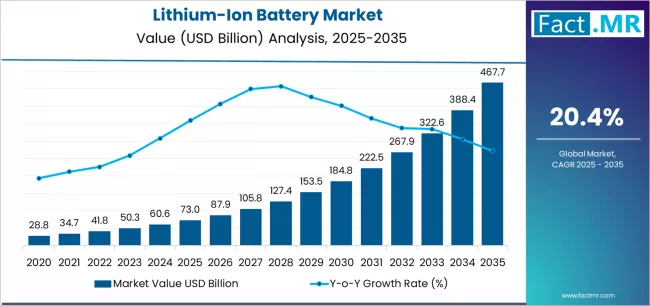
The overall market size is expected to grow by 6.4 times during the same period, supported by accelerating electric vehicle adoption worldwide and expanding applications in energy storage systems across both developed and emerging markets. Additionally, growing application diversity in consumer electronics manufacturing, industrial equipment electrification, and renewable energy integration creates expanding opportunities for lithium-ion battery innovation and specialized product development.
Rising production capacity in Asia Pacific nations, coupled with expanding battery cell manufacturing facilities through advanced gigafactory investments and modern production infrastructure, further accelerate market penetration across diverse application segments. The growing global demand for electric vehicles, particularly in automotive and two-wheeler applications, generates sustained requirements for high-energy-density battery cells and advanced battery management systems.
Technical advancements in battery chemistry technologies demonstrating measurable improvements in energy density, charging speeds, and cycle life performance reinforce manufacturer confidence in lithium-ion battery economics, while renewable energy sector trends toward grid-scale energy storage expand addressable market opportunities beyond traditional consumer electronics applications into utility-scale battery deployment.
Automotive manufacturers and energy companies increasingly incorporate lithium-ion battery systems into vehicle platforms, stationary storage installations, and backup power solutions, creating mainstream consumption channels that extend beyond specialty applications into conventional energy infrastructure environments.
However, fluctuating raw material costs for lithium, cobalt, and nickel and stringent safety regulations for battery thermal management and fire prevention may pose challenges to market expansion. Supply chain complexity during critical mineral procurement in certain regions also influences production capacity, requiring manufacturers to develop diversified sourcing strategies catering to specific operational requirements across different geographical markets.
Technical requirements for battery cell manufacturing and quality control processes and the capital intensity of gigafactory construction may limit accessibility among smaller producers in developing regions with limited infrastructure for advanced lithium-ion battery production and testing systems.
Lithium-Ion Battery Market Year-over-Year Forecast 2025 to 2035
Between 2025 and 2030, the lithium-ion battery market is projected to expand from USD 73.0 billion to USD 185.1 billion, resulting in a value increase of USD 112.1 billion, which represents 28.4% of the total forecast growth for the decade. This phase of development will be shaped by accelerating electric vehicle production and consumer electronics demand, product innovation in high-energy-density formulations and fast-charging capabilities, as well as expanding integration with renewable energy storage initiatives and grid stabilization platforms. Companies are establishing competitive positions through investment in advanced battery chemistry development, high-volume manufacturing capabilities, and strategic market expansion across automotive supply chains, consumer electronics segments, and energy storage applications.
From 2030 to 2035, the market is forecast to grow from USD 185.1 billion to USD 467.7 billion, adding another USD 282.6 billion, which constitutes 71.6% of the overall ten-year expansion. This period is expected to be characterized by the expansion of specialized battery technologies, including solid-state battery development and customized cell configurations tailored for specific application requirements, strategic collaborations between battery manufacturers and automotive OEMs, and an enhanced focus on sustainable production practices and closed-loop recycling systems. The growing emphasis on circular economy principles and battery lifecycle management will drive demand for high-performance lithium-ion battery solutions across diverse industrial applications.
Lithium-Ion Battery Market Key Takeaways
| Metric | Value |
|---|---|
| Market Value (2025) | USD 73.0 billion |
| Market Forecast Value (2035) | USD 467.7 billion |
| Forecast CAGR (2025-2035) | 20.4% |
Why is the Lithium-Ion Battery Market Experiencing Rapid Growth?
The lithium-ion battery market grows by enabling automotive manufacturers, consumer electronics companies, and energy storage operators to access high-performance energy storage solutions that support product performance while meeting industrial demand for consistent power delivery specifications.
Electric vehicle producers and portable device manufacturers face mounting pressure to develop high-performance products with proven energy density and charging characteristics, with lithium-ion battery formulations typically providing 150-300 Wh/kg energy density levels essential for extended operating range and compact device design, making these solutions essential for competitive product positioning in automotive, electronics, and energy storage categories.
The technology industry's need for reliable power sources and consistent performance characteristics creates demand for diverse battery chemistries that can provide superior energy storage capabilities, maintain predictable performance across different operating conditions, and ensure safety compliance without compromising production economics or material specifications.
Government initiatives promoting electric vehicle adoption and renewable energy integration drive deployment in automotive manufacturing facilities, consumer electronics plants, and utility-scale energy storage operations, where lithium-ion battery consumption has a direct impact on product performance outcomes and operational efficiency.
The automotive industry's growing focus on vehicle electrification and emissions reduction further expands market opportunities, with engineering research demonstrating measurable performance advantages from advanced lithium-ion chemistries, including enhanced power-to-weight ratios and improved thermal management characteristics.
However, supply chain complexity during lithium and cobalt sourcing and the technical requirements for cell manufacturing operations and quality assurance processes may limit accessibility among smaller producers and developing regions with limited infrastructure for advanced lithium-ion battery production and testing systems.
Segmental Analysis
The market is segmented by product, application, distribution channel, and region. By product, the market is divided into lithium cobalt oxide, lithium iron phosphate, lithium nickel manganese cobalt, lithium nickel cobalt aluminum oxide, lithium manganese oxide, and lithium titanate.
By application, the market encompasses consumer electronics, automotive, industrial, energy storage systems, and medical devices. By distribution channel, the market includes OEM supply, aftermarket, and direct-to-consumer. Regionally, the market is divided into Asia Pacific, North America, Europe, Latin America, and Middle East & Africa.
Which Product Category is the Most Sought After in the Lithium-Ion Battery Market?
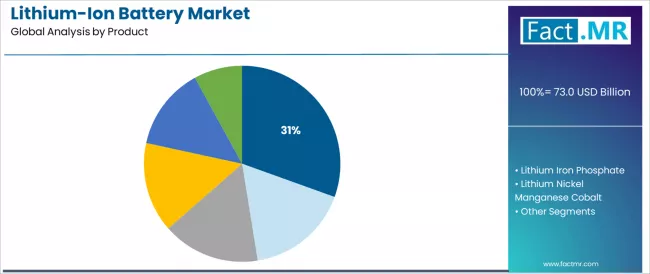
The lithium cobalt oxide segment represents the dominant force in the lithium-ion battery market, capturing approximately 30.5% of total market share in 2025. This established product category encompasses solutions featuring high energy density for premium consumer electronics, including smartphones, tablets, and laptop computers that enable extended battery life, compact form factors, and reliable performance across all portable device applications.
The lithium cobalt oxide segment's market leadership stems from its essential role in high-end consumer electronics manufacturing, with LCO chemistry capable of meeting diverse energy storage requirements while maintaining cost-effective production and operational reliability across all consumer device environments. Within the lithium cobalt oxide segment, smartphone applications account for the largest consumption share, driven by stringent performance requirements and continuous device miniaturization initiatives across global electronics manufacturing operations.
The lithium iron phosphate segment maintains a substantial 24.3% market share, serving automotive manufacturers who require high-safety battery solutions for electric vehicles, energy storage systems, and commercial vehicle applications. These solutions offer robust thermal stability for transportation and stationary storage markets while providing sufficient power delivery to meet performance demands and operational requirements. The lithium nickel manganese cobalt segment accounts for approximately 20.1% of the market, serving electric vehicle manufacturing and power tool applications requiring balanced performance characteristics for automotive-grade and industrial-grade material specifications.
Key advantages driving the lithium cobalt oxide segment include:
- Established manufacturing infrastructure with integrated battery cell production facilities that reduce processing complexity and ensure consistent material availability
- Superior energy density allowing enhanced device performance across different consumer electronics applications without significant cost penalties
- Proven application compatibility, delivering reliable power delivery while maintaining competitiveness against alternative battery chemistries
- Broad industry acceptance enabling straightforward material specification and quality standards across multiple electronics manufacturing sectors
Why do Consumer Electronics Drive Application Segment Leadership?
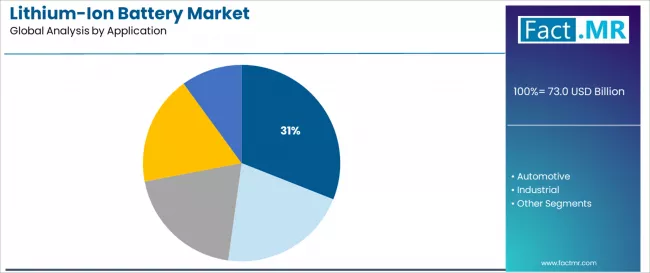
The consumer electronics segment commands approximately 31.0% of the lithium-ion battery market in 2025, representing the largest application category. This dominance stems from pervasive smartphone adoption, expanding tablet market penetration, and growing demand for portable computing devices requiring compact, high-capacity battery solutions.
Consumer electronics manufacturers leverage lithium-ion technology to achieve thin device profiles, extended operating times, and rapid charging capabilities that define competitive advantage in premium device segments. The segment benefits from continuous product refresh cycles, with annual smartphone replacement patterns and evolving consumer expectations for battery performance driving sustained volume growth across major electronics manufacturing regions.
The automotive segment follows with 29.4% market share, reflecting accelerating electric vehicle production and expanding battery electric vehicle adoption across passenger cars, commercial vehicles, and two-wheeler categories. Electric vehicle manufacturers implement lithium-ion battery packs ranging from 40-100 kWh capacity, with battery costs representing 30-40% of total vehicle manufacturing expenses.
The industrial segment captures 17.2% market share through material handling equipment, power tools, and industrial automation applications, while energy storage systems account for 14.1% through grid-scale installations and residential backup power solutions.
What Role does OEM Supply Play in Distribution Dynamics?
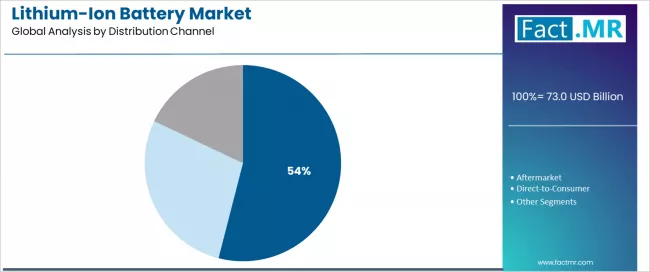
The OEM supply segment represents 54.0% of lithium-ion battery distribution channels in 2025, reflecting direct manufacturer relationships between battery cell producers and end-product manufacturers. Original equipment manufacturers establish long-term supply agreements with battery producers to ensure consistent material availability, technical support integration, and customized cell specifications aligned with specific product requirements. Automotive OEMs typically negotiate multi-year contracts covering gigawatt-hour volumes, while consumer electronics manufacturers implement just-in-time supply arrangements supporting high-volume production schedules.
The aftermarket segment maintains 28.6% distribution share through replacement battery sales, third-party battery packs, and retrofit applications serving existing device populations. Consumer demand for extended device lifespans and battery replacement options creates sustained aftermarket opportunities, particularly in mature markets where device populations exceed new product adoption rates. The direct-to-consumer segment accounts for 17.4% through online battery sales, specialty electronics retailers, and branded battery products targeting end-users seeking replacement solutions or portable power banks.
What are the Drivers, Restraints, and Key Trends of the Lithium-Ion Battery Market?
The market is driven by three concrete demand factors tied to technological advancement and regulatory frameworks. First, accelerating electric vehicle adoption and automotive electrification mandates create growing demand for lithium-ion battery packs, with global electric vehicle sales expanding by 30-40% annually in major automotive markets worldwide, requiring comprehensive battery supply infrastructure. Second, expanding renewable energy deployment and grid modernization initiatives drive increased adoption of battery energy storage systems, with many utility operators implementing gigawatt-scale battery installation programs by 2030. Third, technological advancements in battery chemistry and manufacturing processes enable more effective and efficient energy storage that reduces material costs while improving energy density and cycle life capabilities.
Market restraints include fluctuating lithium prices and critical mineral availability that can deter manufacturers from maintaining competitive pricing strategies, particularly in regions where raw material procurement faces geopolitical constraints or supply concentration risks. Safety regulations and thermal runaway prevention requirements pose another significant challenge, as lithium-ion batteries require sophisticated battery management systems and thermal control mechanisms, potentially causing increased manufacturing complexity and compliance expenditures. Manufacturing quality control and cell-to-cell consistency across large battery pack assemblies create additional market challenges for production optimization, demanding ongoing investment in automated manufacturing systems and quality assurance improvements.
Key trends indicate accelerated gigafactory construction in Asia Pacific markets, particularly China and India, where government incentives and manufacturing scale drive comprehensive lithium-ion battery production adoption. Technology integration trends toward solid-state battery development with enhanced safety profiles, silicon anode technologies with improved energy density, and advanced battery management systems enable optimized performance approaches that increase operational range and minimize degradation rates. However, the market thesis could face disruption if significant advances in alternative battery technologies or major shifts in automotive electrification strategies reduce reliance on traditional lithium-ion battery chemistries.
Analysis of the Lithium-Ion Battery Market by Key Countries
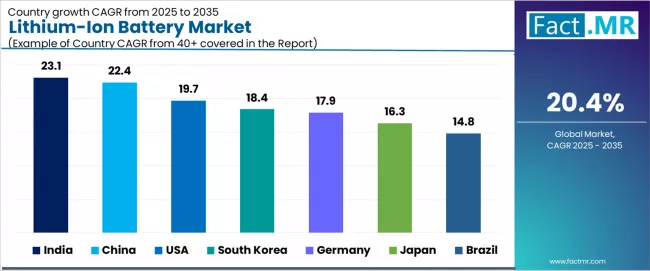
| Country | CAGR (2025-2035) |
|---|---|
| India | 23.1% |
| China | 22.4% |
| South Korea | 18.4% |
| USA | 19.7% |
| Germany | 17.9% |
| Japan | 16.3% |
| Brazil | 14.8% |
The lithium-ion battery market is expanding rapidly, with India leading at a 23.1% CAGR through 2035, driven by government incentives for electric vehicle adoption, expanding two-wheeler and three-wheeler electrification, and growing domestic battery manufacturing capacity. China follows at 22.4%, supported by massive electric vehicle production volumes, integrated battery supply chain networks, and largest global cell manufacturing base. South Korea records 18.4%, reflecting strong battery OEM presence including LG, Samsung, and SK Innovation.
USA posts 19.7%, anchored by Inflation Reduction Act incentives and local gigafactory expansion programs. Germany grows at 17.9%, with energy storage demand and EV manufacturing ecosystem development. Japan advances at 16.3%, emphasizing battery R&D leadership and consumer electronics demand, while Brazil grows steadily at 14.8%, focusing on rising hybrid vehicle adoption and government clean energy initiatives.
India Leads Global Market Expansion
India demonstrates the strongest growth potential in the lithium-ion battery market with a CAGR of 23.1% through 2035. The country's leadership position stems from aggressive government incentives for electric vehicle adoption, expanding two-wheeler and three-wheeler electrification programs, and increasing domestic battery manufacturing operations enabling mainstream lithium-ion battery deployment.
Growth is concentrated in major industrial regions, including Maharashtra, Gujarat, Tamil Nadu, and Karnataka, where manufacturing clusters and expanding automotive infrastructure are implementing lithium-ion battery consumption for enhanced electric vehicle production and energy storage applications.
Distribution channels through automotive OEM partnerships, direct manufacturing agreements, and technology transfer programs expand deployment across electric vehicle manufacturers and consumer electronics producers. The country's growing manufacturing sector provides policy support for battery production, including production-linked incentive schemes for advanced cell manufacturing facilities.
Key market factors:
- Electric vehicle demand concentrated in two-wheeler and three-wheeler segments with comprehensive government subsidy programs
- Infrastructure development through charging network expansion and battery swapping station deployment
- Comprehensive manufacturing ecosystem, including emerging domestic battery cell production capabilities
- Technology partnerships featuring collaborations with international battery manufacturers and knowledge transfer initiatives
China Emerges as Production Powerhouse
In major industrial provinces including Jiangsu, Guangdong, Anhui, and Sichuan, the production and consumption of lithium-ion batteries is accelerating across automotive manufacturing operations and consumer electronics segments, driven by integrated supply chains and massive production capacity. The market demonstrates strong growth momentum with a CAGR of 22.4% through 2035, linked to government electric vehicle mandates, integrated battery manufacturing infrastructure, and sustained domestic automotive demand.
Chinese producers are implementing advanced lithium-ion battery technologies and high-volume manufacturing systems to enhance production economics while meeting growing demand in expanding electric vehicle sectors and renewable energy industries. The country's New Energy Vehicle initiatives create persistent demand for battery solutions, while increasing emphasis on battery recycling drives adoption of circular economy production systems.
Key development areas:
- Electric vehicle and consumer electronics sectors leading lithium-ion battery consumption with comprehensive production programs
- Integrated supply chains providing efficient material flow with extensive logistics infrastructure
- Technology leadership in battery chemistry innovation and manufacturing automation are expanding market capabilities
- Integration of battery recycling facilities and comprehensive material recovery protocols
South Korea Shows Technology Leadership
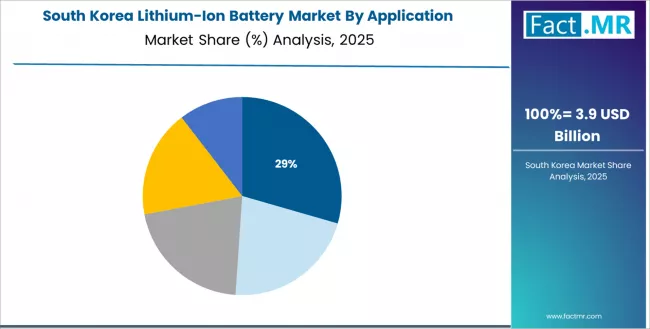
South Korea's market expansion is driven by established battery OEM presence, including LG Energy Solution, Samsung SDI, and SK Innovation operations across multiple production facilities. The country demonstrates promising growth potential with a CAGR of 18.4% through 2035, supported by advanced battery technology development, strong automotive industry partnerships, and growing integration with global electric vehicle supply chains.
South Korean producers maintain implementation advantages through proprietary battery chemistries and manufacturing expertise, requiring continuous investment in R&D facilities and support from government innovation programs. However, growing international competition and capacity expansion in competing markets create compelling requirements for technology differentiation, particularly in battery management systems where Korean manufacturers have direct impact on automotive battery performance.
Key market characteristics:
- Automotive battery and energy storage segments showing fastest growth with substantial increase in production capacity
- Technology advancement trends focused on next-generation battery chemistries and solid-state battery development
- Future projections indicate the need for expanded international manufacturing footprint and strategic partnerships
- Growing emphasis on battery safety certifications and quality assurance methodologies
USA Demonstrates Strong Growth Momentum
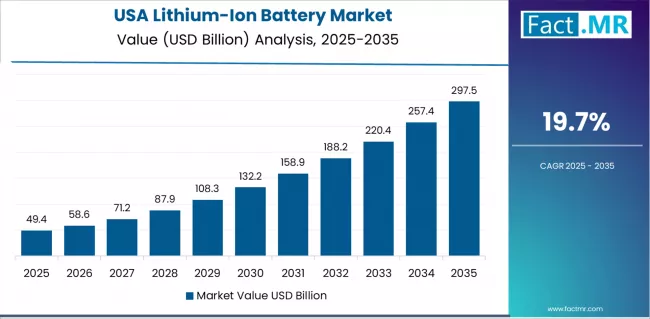
The USA market shows robust expansion based on Inflation Reduction Act incentives and local gigafactory construction for enhanced domestic production capability. The country shows strong potential with a CAGR of 19.7% through 2035, driven by reshoring initiatives for battery manufacturing, expanding electric vehicle production capacity, and the expansion of grid-scale energy storage facilities in major regions, including Southwest, Southeast, and Midwest states.
American manufacturers are adopting comprehensive lithium-ion battery deployment strategies for automotive electrification and renewable energy integration, particularly in regions with supportive policy frameworks and established automotive manufacturing presence demanding comprehensive supply chain localization. Technology deployment channels through domestic gigafactory operations and international partnerships expand coverage across automotive manufacturers and utility-scale energy storage operators.
Leading market segments:
- Electric vehicle production and energy storage installations in major manufacturing regions implementing comprehensive electrification strategies
- Strategic partnerships with international battery manufacturers, achieving technology transfer and production capacity development
- Government incentives through Inflation Reduction Act and infrastructure investment programs are expanding adoption rates
- Focus on domestic supply chain development and critical mineral processing capabilities
Germany Emphasizes Automotive Integration
In major manufacturing regions including Bavaria, Baden-Württemberg, Lower Saxony, and North Rhine-Westphalia, automotive manufacturers and energy storage operators are implementing comprehensive lithium-ion battery integration strategies to optimize existing vehicle platforms and improve energy storage outcomes, with documented case studies showing significant performance improvements through advanced battery management systems and thermal control techniques.
The market shows steady growth potential with a CAGR of 17.9% through 2035, linked to established automotive industry infrastructure, comprehensive renewable energy targets, and ongoing electric vehicle production requirements in major regions. German manufacturers are adopting consistent battery supply strategies and quality assurance protocols to enhance manufacturing efficiency while maintaining performance standards demanded by premium automotive specifications and energy storage applications. The country's advanced engineering capabilities create persistent demand for high-quality battery solutions and technical integration services that align with existing automotive production systems.
Market development factors:
- Automotive manufacturers and energy companies leading lithium-ion battery adoption across Germany
- Energy transition policies and renewable energy mandates providing support for battery storage deployment
- Strategic relationships between German automotive OEMs and international battery suppliers are expanding supply security
- Emphasis on battery lifecycle management and second-life application development
Japan Shows R&D Excellence
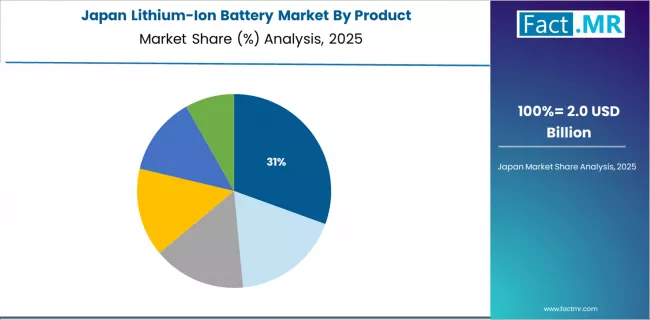
Japan's lithium-ion battery market demonstrates competitive positioning focused on advanced battery technology research and consumer electronics integration, with documented adoption of high-performance battery chemistries, achieving superior energy density through proprietary material formulations in major electronics manufacturing centers.
The country maintains steady growth momentum with a CAGR of 16.3% through 2035, driven by established battery technology leadership, strong consumer electronics industry presence, and strategic positioning for specialty battery applications. Major research institutions and manufacturing facilities, including operations in Tokyo, Osaka, and surrounding prefectures, showcase advanced deployment of lithium-ion battery development programs where material innovation supports competitive performance targets and comprehensive quality programs.
Key market characteristics:
- Consumer electronics and specialty battery applications driving lithium-ion battery development with emphasis on miniaturization and performance optimization
- Technology collaboration between Japanese research institutions and commercial manufacturers enabling continuous innovation
- Strategic partnerships between domestic battery producers and international automotive companies are expanding market opportunities
- Emphasis on solid-state battery development and next-generation energy storage technologies
Brazil Shows Emerging Market Potential
Brazil's lithium-ion battery market demonstrates developing landscape, characterized by increasing integration of hybrid vehicle production with existing automotive manufacturing operations across vehicle assembly facilities and emerging battery component manufacturing.
The country shows steady growth momentum with a CAGR of 14.8% through 2035, driven by government clean energy initiatives for renewable energy development in emerging production facilities. Brazil's emphasis on flex-fuel vehicle heritage and biofuel integration creates requirements for hybrid powertrain solutions that support comprehensive automotive electrification initiatives and environmental compliance in transportation sectors.
The market benefits from growing partnerships between international automotive manufacturers and domestic production facilities, creating supply ecosystems that prioritize local content development and manufacturing capability building. Automotive manufacturing facilities in major production regions showcase emerging lithium-ion battery implementations where hybrid vehicle assembly achieves production scale through integrated manufacturing programs.
Key market characteristics:
- Hybrid vehicle production and renewable energy storage driving lithium-ion battery requirements with emphasis on market development
- Manufacturing partnerships enabling technology transfer with automotive industry collaboration programs
- Government incentives for clean transportation and renewable energy adoption are expanding deployment potential
- Emphasis on domestic supply chain development and local battery assembly capabilities
Europe Market Split by Country

The lithium-ion battery market in Europe is projected to grow from USD 12.8 billion in 2025 to USD 82.1 billion by 2035, registering a CAGR of 20.4% over the forecast period. Germany is expected to maintain its leadership position with a 29.3% market share in 2025, supported by its advanced automotive manufacturing infrastructure, comprehensive electric vehicle production programs, and strong battery technology development across major industrial centers.
France follows with a 21.5% share in 2025, driven by established automotive battery production operations and integrated electric vehicle manufacturing sectors. Poland holds a 18.2% share in 2025 through its growing battery gigafactory investments and strategic positioning in European supply chains.
Hungary commands a 16.8% share, while Rest of Europe accounts for 14.2% in 2025. By 2035, Germany is projected to hold 28.7% share, France 21.9%, Poland 18.8%, Hungary 16.4%, and Rest of Europe 14.2%, reflecting sustained growth momentum across all major European markets and increasing lithium-ion battery adoption in diversified automotive and energy storage applications implementing advanced battery manufacturing programs.
Competitive Landscape of the Lithium-Ion Battery Market
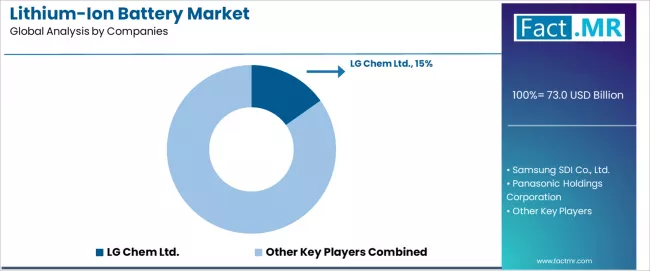
The lithium-ion battery market features approximately 30-40 meaningful players with moderate concentration, where the top three companies control roughly 40-50% of global production capacity through established cell manufacturing operations and extensive customer relationships across automotive and consumer electronics sectors.
Market leaders include LG Chem, Samsung SDI, and Panasonic, which maintain competitive advantages through comprehensive lithium-ion battery production portfolios, global manufacturing networks, and deep expertise in battery chemistry development and cell manufacturing sectors, creating strong customer relationships among automotive manufacturers and consumer electronics companies.
These companies leverage established gigafactory facilities and ongoing capacity expansion initiatives to defend market positions while expanding into adjacent energy storage applications and specialty battery markets. LG Chem commands a 15.2% market share through integrated production operations and strategic positioning in automotive and energy storage markets.
Challengers encompass BYD Co. Ltd., A123 Systems, and Saft, which compete through diversified product portfolios and strong regional presence in key manufacturing markets. Specialty producers, including Hitachi, Toshiba, and GS Yuasa, focus on specific geographical regions or customer segments, offering differentiated capabilities in regional supply reliability, specialized battery chemistries, and technical support services.
Regional players and emerging producers create competitive pressure through cost-advantaged production capabilities and strategic market positioning, particularly in high-growth markets including China and India, where local presence provides advantages in logistics optimization and customer proximity.
Market dynamics favor companies that combine advanced battery chemistry technologies with comprehensive quality management systems that address the complete value chain from raw material sourcing through cell manufacturing operations and pack assembly. Strategic investments in vertical integration initiatives and technology partnerships enable cost optimization and supply security across production operations.
Global Lithium-Ion Battery Market - Stakeholder Contribution Framework
Lithium-ion battery products represent a critical energy storage technology that enables automotive manufacturers, consumer electronics companies, and energy storage operators to enhance product performance and operational efficiency without substantial infrastructure modifications, typically providing essential power delivery functionality and energy storage capabilities while supporting diverse application requirements.
With the market projected to grow from USD 73.0 billion in 2025 to USD 467.7 billion by 2035 at a 20.4% CAGR, these products offer compelling advantages - high energy density, reliable cycle life, and versatile application capabilities - making them essential for electric vehicle production (fastest growing segment), consumer electronics manufacturing (largest segment), and diverse energy storage applications seeking proven battery technologies. Scaling production capacity and market development requires coordinated action across government policy, industry standards, battery manufacturers, technology providers, and research institutions.
How Governments Could Spur Local Production and Adoption?
- Electric Vehicle Incentive Programs: Include lithium-ion battery production capabilities in national industrial strategies, providing targeted funding for gigafactory construction in regions with competitive energy resources and supporting local battery manufacturers through investment incentives and development support.
- Critical Mineral Security & Supply Chain Support: Implement strategic mineral reserve programs for lithium, cobalt, and nickel, provide access to domestic mineral resources through responsible mining frameworks, and establish processing infrastructure that supports secure raw material supply chains.
- Technology Development & Infrastructure Investment: Create favorable regulatory frameworks for battery manufacturing operations, provide funding for charging infrastructure deployment, and develop recycling facilities that support circular economy principles and material recovery.
- Skills Development & Workforce Training: Fund technical education programs for battery engineers, cell manufacturing technicians, and quality control specialists. Invest in technology transfer initiatives that bridge research institutions with commercial battery production and assembly operations.
How Industry Bodies Could Support Market Development?
- Safety Standards & Certification: Define standardized safety specifications for lithium-ion battery applications across automotive, consumer electronics, and energy storage sectors, establish universal testing protocols and performance metrics, and create certification programs for battery quality that manufacturers can rely on.
- Market Education & Best Practices: Lead communication initiatives that demonstrate lithium-ion battery applications, emphasizing proven performance benefits, safety characteristics, and lifecycle advantages compared to alternative energy storage technologies and battery chemistries.
- Sustainability Standards: Develop environmental performance benchmarks for battery production operations, comprehensive carbon footprint methodologies, and recycling best practices, ensuring responsible manufacturing across different production environments and operational scales.
How Manufacturers and Technology Players Could Strengthen the Ecosystem?
- Battery Chemistry Innovation: Develop next-generation lithium-ion battery technologies with enhanced energy density capabilities, improved safety characteristics, and application-specific features that enhance product performance while improving production economics and environmental sustainability.
- Manufacturing Excellence Programs: Provide comprehensive technical support that integrates cell testing, battery management system development, thermal management optimization, and performance validation, enabling customers to maximize product performance and operational efficiency.
- Supply Chain Integration: Offer flexible supply arrangements for automotive manufacturers and consumer electronics companies, including long-term supply agreements, inventory management services, and logistics optimization pathways that keep battery supply consistent with customer production requirements.
Key Players in the Lithium-Ion Battery Market
- LG Chem Ltd.
- Samsung SDI Co., Ltd.
- Panasonic Holdings Corporation
- BYD Co. Ltd.
- A123 Systems LLC
- Saft Groupe S.A.
- Hitachi, Ltd.
- Toshiba Corporation
- GS Yuasa Corporation
- Johnson Controls International plc
Scope of the Report
| Items | Values |
|---|---|
| Quantitative Units | USD 73.0 Billion |
| Product | Lithium Cobalt Oxide, Lithium Iron Phosphate, Lithium Nickel Manganese Cobalt, Lithium Nickel Cobalt Aluminum Oxide, Lithium Manganese Oxide, Lithium Titanate |
| Application | Consumer Electronics, Automotive, Industrial, Energy Storage Systems, Medical Devices |
| Distribution Channel | OEM Supply, Aftermarket, Direct-to-Consumer |
| Regions Covered | Asia Pacific, North America, Europe, Latin America, Middle East & Africa |
| Country Covered | India, China, South Korea, USA, Germany, Japan, Brazil, and 40+ countries |
| Key Companies Profiled | LG Chem, Samsung SDI, Panasonic, BYD Co. Ltd., A123 Systems, Saft, Hitachi, Toshiba, GS Yuasa, Johnson Controls |
| Additional Attributes | Dollar sales by product and application categories, regional production trends across Asia Pacific, North America, and Europe, competitive landscape with battery manufacturers and technology companies, battery chemistry specifications and performance requirements, integration with automotive manufacturing facilities and consumer electronics production operations. |
Lithium-Ion Battery Market by Segments
-
Product :
- Lithium Cobalt Oxide
- Lithium Iron Phosphate
- Lithium Nickel Manganese Cobalt
- Lithium Nickel Cobalt Aluminum Oxide
- Lithium Manganese Oxide
- Lithium Titanate
-
Application :
- Consumer Electronics
- Automotive
- Industrial
- Energy Storage Systems
- Medical Devices
-
Distribution Channel :
- OEM Supply
- Aftermarket
- Direct-to-Consumer
-
Region :
- Asia Pacific
- China
- Japan
- South Korea
- India
- Australia & New Zealand
- ASEAN
- Rest of Asia Pacific
- North America
- USA
- Canada
- Mexico
- Europe
- Germany
- France
- Poland
- Hungary
- Rest of Europe
- Latin America
- Brazil
- Rest of Latin America
- Middle East & Africa
- Kingdom of Saudi Arabia
- Other GCC Countries
- Turkey
- South Africa
- Rest of Middle East & Africa
- Asia Pacific
Table of Content
- Executive Summary
- Global Market Outlook
- Demand to side Trends
- Supply to side Trends
- Technology Roadmap Analysis
- Analysis and Recommendations
- Market Overview
- Market Coverage / Taxonomy
- Market Definition / Scope / Limitations
- Market Background
- Market Dynamics
- Drivers
- Restraints
- Opportunity
- Trends
- Scenario Forecast
- Demand in Optimistic Scenario
- Demand in Likely Scenario
- Demand in Conservative Scenario
- Opportunity Map Analysis
- Product Life Cycle Analysis
- Supply Chain Analysis
- Investment Feasibility Matrix
- Value Chain Analysis
- PESTLE and Porter’s Analysis
- Regulatory Landscape
- Regional Parent Market Outlook
- Production and Consumption Statistics
- Import and Export Statistics
- Market Dynamics
- Global Market Analysis 2020 to 2024 and Forecast, 2025 to 2035
- Historical Market Size Value (USD Million) Analysis, 2020 to 2024
- Current and Future Market Size Value (USD Million) Projections, 2025 to 2035
- Y to o to Y Growth Trend Analysis
- Absolute $ Opportunity Analysis
- Global Market Pricing Analysis 2020 to 2024 and Forecast 2025 to 2035
- Global Market Analysis 2020 to 2024 and Forecast 2025 to 2035, By Product
- Introduction / Key Findings
- Historical Market Size Value (USD Million) Analysis By Product, 2020 to 2024
- Current and Future Market Size Value (USD Million) Analysis and Forecast By Product, 2025 to 2035
- Lithium Cobalt Oxide
- Lithium Iron Phosphate
- Lithium Nickel Manganese Cobalt
- Lithium Nickel Cobalt Aluminum Oxide
- Lithium Manganese Oxide
- Lithium Titanate
- Y to o to Y Growth Trend Analysis By Product, 2020 to 2024
- Absolute $ Opportunity Analysis By Product, 2025 to 2035
- Global Market Analysis 2020 to 2024 and Forecast 2025 to 2035, By Application
- Introduction / Key Findings
- Historical Market Size Value (USD Million) Analysis By Application, 2020 to 2024
- Current and Future Market Size Value (USD Million) Analysis and Forecast By Application, 2025 to 2035
- Consumer Electronics
- Automotive
- Industrial
- Energy Storage Systems
- Medical Devices
- Y to o to Y Growth Trend Analysis By Application, 2020 to 2024
- Absolute $ Opportunity Analysis By Application, 2025 to 2035
- Global Market Analysis 2020 to 2024 and Forecast 2025 to 2035, By Distribution Channel
- Introduction / Key Findings
- Historical Market Size Value (USD Million) Analysis By Distribution Channel, 2020 to 2024
- Current and Future Market Size Value (USD Million) Analysis and Forecast By Distribution Channel, 2025 to 2035
- OEM Supply
- Aftermarket
- Direct-to-Consumer
- Y to o to Y Growth Trend Analysis By Distribution Channel, 2020 to 2024
- Absolute $ Opportunity Analysis By Distribution Channel, 2025 to 2035
- Global Market Analysis 2020 to 2024 and Forecast 2025 to 2035, By Region
- Introduction
- Historical Market Size Value (USD Million) Analysis By Region, 2020 to 2024
- Current Market Size Value (USD Million) Analysis and Forecast By Region, 2025 to 2035
- North America
- Latin America
- Western Europe
- Eastern Europe
- East Asia
- South Asia and Pacific
- Middle East & Africa
- Market Attractiveness Analysis By Region
- North America Market Analysis 2020 to 2024 and Forecast 2025 to 2035, By Country
- Historical Market Size Value (USD Million) Trend Analysis By Market Taxonomy, 2020 to 2024
- Market Size Value (USD Million) Forecast By Market Taxonomy, 2025 to 2035
- By Country
- USA
- Canada
- Mexico
- By Product
- By Application
- By Distribution Channel
- By Country
- Market Attractiveness Analysis
- By Country
- By Product
- By Application
- By Distribution Channel
- Key Takeaways
- Latin America Market Analysis 2020 to 2024 and Forecast 2025 to 2035, By Country
- Historical Market Size Value (USD Million) Trend Analysis By Market Taxonomy, 2020 to 2024
- Market Size Value (USD Million) Forecast By Market Taxonomy, 2025 to 2035
- By Country
- Brazil
- Chile
- Rest of Latin America
- By Product
- By Application
- By Distribution Channel
- By Country
- Market Attractiveness Analysis
- By Country
- By Product
- By Application
- By Distribution Channel
- Key Takeaways
- Western Europe Market Analysis 2020 to 2024 and Forecast 2025 to 2035, By Country
- Historical Market Size Value (USD Million) Trend Analysis By Market Taxonomy, 2020 to 2024
- Market Size Value (USD Million) Forecast By Market Taxonomy, 2025 to 2035
- By Country
- Germany
- UK
- Italy
- Spain
- France
- Nordic
- BENELUX
- Rest of Western Europe
- By Product
- By Application
- By Distribution Channel
- By Country
- Market Attractiveness Analysis
- By Country
- By Product
- By Application
- By Distribution Channel
- Key Takeaways
- Eastern Europe Market Analysis 2020 to 2024 and Forecast 2025 to 2035, By Country
- Historical Market Size Value (USD Million) Trend Analysis By Market Taxonomy, 2020 to 2024
- Market Size Value (USD Million) Forecast By Market Taxonomy, 2025 to 2035
- By Country
- Russia
- Poland
- Hungary
- Balkan & Baltic
- Rest of Eastern Europe
- By Product
- By Application
- By Distribution Channel
- By Country
- Market Attractiveness Analysis
- By Country
- By Product
- By Application
- By Distribution Channel
- Key Takeaways
- East Asia Market Analysis 2020 to 2024 and Forecast 2025 to 2035, By Country
- Historical Market Size Value (USD Million) Trend Analysis By Market Taxonomy, 2020 to 2024
- Market Size Value (USD Million) Forecast By Market Taxonomy, 2025 to 2035
- By Country
- China
- Japan
- South Korea
- By Product
- By Application
- By Distribution Channel
- By Country
- Market Attractiveness Analysis
- By Country
- By Product
- By Application
- By Distribution Channel
- Key Takeaways
- South Asia and Pacific Market Analysis 2020 to 2024 and Forecast 2025 to 2035, By Country
- Historical Market Size Value (USD Million) Trend Analysis By Market Taxonomy, 2020 to 2024
- Market Size Value (USD Million) Forecast By Market Taxonomy, 2025 to 2035
- By Country
- India
- ASEAN
- Australia & New Zealand
- Rest of South Asia and Pacific
- By Product
- By Application
- By Distribution Channel
- By Country
- Market Attractiveness Analysis
- By Country
- By Product
- By Application
- By Distribution Channel
- Key Takeaways
- Middle East & Africa Market Analysis 2020 to 2024 and Forecast 2025 to 2035, By Country
- Historical Market Size Value (USD Million) Trend Analysis By Market Taxonomy, 2020 to 2024
- Market Size Value (USD Million) Forecast By Market Taxonomy, 2025 to 2035
- By Country
- Kingdom of Saudi Arabia
- Other GCC Countries
- Turkiye
- South Africa
- Other African Union
- Rest of Middle East & Africa
- By Product
- By Application
- By Distribution Channel
- By Country
- Market Attractiveness Analysis
- By Country
- By Product
- By Application
- By Distribution Channel
- Key Takeaways
- Key Countries Market Analysis
- USA
- Pricing Analysis
- Market Share Analysis, 2024
- By Product
- By Application
- By Distribution Channel
- Canada
- Pricing Analysis
- Market Share Analysis, 2024
- By Product
- By Application
- By Distribution Channel
- Mexico
- Pricing Analysis
- Market Share Analysis, 2024
- By Product
- By Application
- By Distribution Channel
- Brazil
- Pricing Analysis
- Market Share Analysis, 2024
- By Product
- By Application
- By Distribution Channel
- Chile
- Pricing Analysis
- Market Share Analysis, 2024
- By Product
- By Application
- By Distribution Channel
- Germany
- Pricing Analysis
- Market Share Analysis, 2024
- By Product
- By Application
- By Distribution Channel
- UK
- Pricing Analysis
- Market Share Analysis, 2024
- By Product
- By Application
- By Distribution Channel
- Italy
- Pricing Analysis
- Market Share Analysis, 2024
- By Product
- By Application
- By Distribution Channel
- Spain
- Pricing Analysis
- Market Share Analysis, 2024
- By Product
- By Application
- By Distribution Channel
- France
- Pricing Analysis
- Market Share Analysis, 2024
- By Product
- By Application
- By Distribution Channel
- India
- Pricing Analysis
- Market Share Analysis, 2024
- By Product
- By Application
- By Distribution Channel
- ASEAN
- Pricing Analysis
- Market Share Analysis, 2024
- By Product
- By Application
- By Distribution Channel
- Australia & New Zealand
- Pricing Analysis
- Market Share Analysis, 2024
- By Product
- By Application
- By Distribution Channel
- China
- Pricing Analysis
- Market Share Analysis, 2024
- By Product
- By Application
- By Distribution Channel
- Japan
- Pricing Analysis
- Market Share Analysis, 2024
- By Product
- By Application
- By Distribution Channel
- South Korea
- Pricing Analysis
- Market Share Analysis, 2024
- By Product
- By Application
- By Distribution Channel
- Russia
- Pricing Analysis
- Market Share Analysis, 2024
- By Product
- By Application
- By Distribution Channel
- Poland
- Pricing Analysis
- Market Share Analysis, 2024
- By Product
- By Application
- By Distribution Channel
- Hungary
- Pricing Analysis
- Market Share Analysis, 2024
- By Product
- By Application
- By Distribution Channel
- Kingdom of Saudi Arabia
- Pricing Analysis
- Market Share Analysis, 2024
- By Product
- By Application
- By Distribution Channel
- Turkiye
- Pricing Analysis
- Market Share Analysis, 2024
- By Product
- By Application
- By Distribution Channel
- South Africa
- Pricing Analysis
- Market Share Analysis, 2024
- By Product
- By Application
- By Distribution Channel
- USA
- Market Structure Analysis
- Competition Dashboard
- Competition Benchmarking
- Market Share Analysis of Top Players
- By Regional
- By Product
- By Application
- By Distribution Channel
- Competition Analysis
- Competition Deep Dive
- LG Chem Ltd.
- Overview
- Product Portfolio
- Profitability by Market Segments (Product/Age /Sales Channel/Region)
- Sales Footprint
- Strategy Overview
- Marketing Strategy
- Product Strategy
- Channel Strategy
- Samsung SDI Co., Ltd.
- Panasonic Holdings Corporation
- BYD Co. Ltd.
- A123 Systems LLC
- Saft Groupe S.A.
- Hitachi, Ltd.
- Toshiba Corporation
- GS Yuasa Corporation
- Johnson Controls International plc
- LG Chem Ltd.
- Competition Deep Dive
- Assumptions & Acronyms Used
- Research Methodology
List Of Table
- Table 1: Global Market Value (USD Million) Forecast by Region, 2020 to 2035
- Table 2: Global Market Value (USD Million) Forecast by Product, 2020 to 2035
- Table 3: Global Market Value (USD Million) Forecast by Application, 2020 to 2035
- Table 4: Global Market Value (USD Million) Forecast by Distribution Channel, 2020 to 2035
- Table 5: North America Market Value (USD Million) Forecast by Country, 2020 to 2035
- Table 6: North America Market Value (USD Million) Forecast by Product, 2020 to 2035
- Table 7: North America Market Value (USD Million) Forecast by Application, 2020 to 2035
- Table 8: North America Market Value (USD Million) Forecast by Distribution Channel, 2020 to 2035
- Table 9: Latin America Market Value (USD Million) Forecast by Country, 2020 to 2035
- Table 10: Latin America Market Value (USD Million) Forecast by Product, 2020 to 2035
- Table 11: Latin America Market Value (USD Million) Forecast by Application, 2020 to 2035
- Table 12: Latin America Market Value (USD Million) Forecast by Distribution Channel, 2020 to 2035
- Table 13: Western Europe Market Value (USD Million) Forecast by Country, 2020 to 2035
- Table 14: Western Europe Market Value (USD Million) Forecast by Product, 2020 to 2035
- Table 15: Western Europe Market Value (USD Million) Forecast by Application, 2020 to 2035
- Table 16: Western Europe Market Value (USD Million) Forecast by Distribution Channel, 2020 to 2035
- Table 17: Eastern Europe Market Value (USD Million) Forecast by Country, 2020 to 2035
- Table 18: Eastern Europe Market Value (USD Million) Forecast by Product, 2020 to 2035
- Table 19: Eastern Europe Market Value (USD Million) Forecast by Application, 2020 to 2035
- Table 20: Eastern Europe Market Value (USD Million) Forecast by Distribution Channel, 2020 to 2035
- Table 21: East Asia Market Value (USD Million) Forecast by Country, 2020 to 2035
- Table 22: East Asia Market Value (USD Million) Forecast by Product, 2020 to 2035
- Table 23: East Asia Market Value (USD Million) Forecast by Application, 2020 to 2035
- Table 24: East Asia Market Value (USD Million) Forecast by Distribution Channel, 2020 to 2035
- Table 25: South Asia and Pacific Market Value (USD Million) Forecast by Country, 2020 to 2035
- Table 26: South Asia and Pacific Market Value (USD Million) Forecast by Product, 2020 to 2035
- Table 27: South Asia and Pacific Market Value (USD Million) Forecast by Application, 2020 to 2035
- Table 28: South Asia and Pacific Market Value (USD Million) Forecast by Distribution Channel, 2020 to 2035
- Table 29: Middle East & Africa Market Value (USD Million) Forecast by Country, 2020 to 2035
- Table 30: Middle East & Africa Market Value (USD Million) Forecast by Product, 2020 to 2035
- Table 31: Middle East & Africa Market Value (USD Million) Forecast by Application, 2020 to 2035
- Table 32: Middle East & Africa Market Value (USD Million) Forecast by Distribution Channel, 2020 to 2035
List Of Figures
- Figure 1: Global Market Pricing Analysis
- Figure 2: Global Market Value (USD Million) Forecast 2020 to 2035
- Figure 3: Global Market Value Share and BPS Analysis by Product, 2025 and 2035
- Figure 4: Global Market Y to o to Y Growth Comparison by Product, 2025 to 2035
- Figure 5: Global Market Attractiveness Analysis by Product
- Figure 6: Global Market Value Share and BPS Analysis by Application, 2025 and 2035
- Figure 7: Global Market Y to o to Y Growth Comparison by Application, 2025 to 2035
- Figure 8: Global Market Attractiveness Analysis by Application
- Figure 9: Global Market Value Share and BPS Analysis by Distribution Channel, 2025 and 2035
- Figure 10: Global Market Y to o to Y Growth Comparison by Distribution Channel, 2025 to 2035
- Figure 11: Global Market Attractiveness Analysis by Distribution Channel
- Figure 12: Global Market Value (USD Million) Share and BPS Analysis by Region, 2025 and 2035
- Figure 13: Global Market Y to o to Y Growth Comparison by Region, 2025 to 2035
- Figure 14: Global Market Attractiveness Analysis by Region
- Figure 15: North America Market Incremental Dollar Opportunity, 2025 to 2035
- Figure 16: Latin America Market Incremental Dollar Opportunity, 2025 to 2035
- Figure 17: Western Europe Market Incremental Dollar Opportunity, 2025 to 2035
- Figure 18: Eastern Europe Market Incremental Dollar Opportunity, 2025 to 2035
- Figure 19: East Asia Market Incremental Dollar Opportunity, 2025 to 2035
- Figure 20: South Asia and Pacific Market Incremental Dollar Opportunity, 2025 to 2035
- Figure 21: Middle East & Africa Market Incremental Dollar Opportunity, 2025 to 2035
- Figure 22: North America Market Value Share and BPS Analysis by Country, 2025 and 2035
- Figure 23: North America Market Value Share and BPS Analysis by Product, 2025 and 2035
- Figure 24: North America Market Y to o to Y Growth Comparison by Product, 2025 to 2035
- Figure 25: North America Market Attractiveness Analysis by Product
- Figure 26: North America Market Value Share and BPS Analysis by Application, 2025 and 2035
- Figure 27: North America Market Y to o to Y Growth Comparison by Application, 2025 to 2035
- Figure 28: North America Market Attractiveness Analysis by Application
- Figure 29: North America Market Value Share and BPS Analysis by Distribution Channel, 2025 and 2035
- Figure 30: North America Market Y to o to Y Growth Comparison by Distribution Channel, 2025 to 2035
- Figure 31: North America Market Attractiveness Analysis by Distribution Channel
- Figure 32: Latin America Market Value Share and BPS Analysis by Country, 2025 and 2035
- Figure 33: Latin America Market Value Share and BPS Analysis by Product, 2025 and 2035
- Figure 34: Latin America Market Y to o to Y Growth Comparison by Product, 2025 to 2035
- Figure 35: Latin America Market Attractiveness Analysis by Product
- Figure 36: Latin America Market Value Share and BPS Analysis by Application, 2025 and 2035
- Figure 37: Latin America Market Y to o to Y Growth Comparison by Application, 2025 to 2035
- Figure 38: Latin America Market Attractiveness Analysis by Application
- Figure 39: Latin America Market Value Share and BPS Analysis by Distribution Channel, 2025 and 2035
- Figure 40: Latin America Market Y to o to Y Growth Comparison by Distribution Channel, 2025 to 2035
- Figure 41: Latin America Market Attractiveness Analysis by Distribution Channel
- Figure 42: Western Europe Market Value Share and BPS Analysis by Country, 2025 and 2035
- Figure 43: Western Europe Market Value Share and BPS Analysis by Product, 2025 and 2035
- Figure 44: Western Europe Market Y to o to Y Growth Comparison by Product, 2025 to 2035
- Figure 45: Western Europe Market Attractiveness Analysis by Product
- Figure 46: Western Europe Market Value Share and BPS Analysis by Application, 2025 and 2035
- Figure 47: Western Europe Market Y to o to Y Growth Comparison by Application, 2025 to 2035
- Figure 48: Western Europe Market Attractiveness Analysis by Application
- Figure 49: Western Europe Market Value Share and BPS Analysis by Distribution Channel, 2025 and 2035
- Figure 50: Western Europe Market Y to o to Y Growth Comparison by Distribution Channel, 2025 to 2035
- Figure 51: Western Europe Market Attractiveness Analysis by Distribution Channel
- Figure 52: Eastern Europe Market Value Share and BPS Analysis by Country, 2025 and 2035
- Figure 53: Eastern Europe Market Value Share and BPS Analysis by Product, 2025 and 2035
- Figure 54: Eastern Europe Market Y to o to Y Growth Comparison by Product, 2025 to 2035
- Figure 55: Eastern Europe Market Attractiveness Analysis by Product
- Figure 56: Eastern Europe Market Value Share and BPS Analysis by Application, 2025 and 2035
- Figure 57: Eastern Europe Market Y to o to Y Growth Comparison by Application, 2025 to 2035
- Figure 58: Eastern Europe Market Attractiveness Analysis by Application
- Figure 59: Eastern Europe Market Value Share and BPS Analysis by Distribution Channel, 2025 and 2035
- Figure 60: Eastern Europe Market Y to o to Y Growth Comparison by Distribution Channel, 2025 to 2035
- Figure 61: Eastern Europe Market Attractiveness Analysis by Distribution Channel
- Figure 62: East Asia Market Value Share and BPS Analysis by Country, 2025 and 2035
- Figure 63: East Asia Market Value Share and BPS Analysis by Product, 2025 and 2035
- Figure 64: East Asia Market Y to o to Y Growth Comparison by Product, 2025 to 2035
- Figure 65: East Asia Market Attractiveness Analysis by Product
- Figure 66: East Asia Market Value Share and BPS Analysis by Application, 2025 and 2035
- Figure 67: East Asia Market Y to o to Y Growth Comparison by Application, 2025 to 2035
- Figure 68: East Asia Market Attractiveness Analysis by Application
- Figure 69: East Asia Market Value Share and BPS Analysis by Distribution Channel, 2025 and 2035
- Figure 70: East Asia Market Y to o to Y Growth Comparison by Distribution Channel, 2025 to 2035
- Figure 71: East Asia Market Attractiveness Analysis by Distribution Channel
- Figure 72: South Asia and Pacific Market Value Share and BPS Analysis by Country, 2025 and 2035
- Figure 73: South Asia and Pacific Market Value Share and BPS Analysis by Product, 2025 and 2035
- Figure 74: South Asia and Pacific Market Y to o to Y Growth Comparison by Product, 2025 to 2035
- Figure 75: South Asia and Pacific Market Attractiveness Analysis by Product
- Figure 76: South Asia and Pacific Market Value Share and BPS Analysis by Application, 2025 and 2035
- Figure 77: South Asia and Pacific Market Y to o to Y Growth Comparison by Application, 2025 to 2035
- Figure 78: South Asia and Pacific Market Attractiveness Analysis by Application
- Figure 79: South Asia and Pacific Market Value Share and BPS Analysis by Distribution Channel, 2025 and 2035
- Figure 80: South Asia and Pacific Market Y to o to Y Growth Comparison by Distribution Channel, 2025 to 2035
- Figure 81: South Asia and Pacific Market Attractiveness Analysis by Distribution Channel
- Figure 82: Middle East & Africa Market Value Share and BPS Analysis by Country, 2025 and 2035
- Figure 83: Middle East & Africa Market Value Share and BPS Analysis by Product, 2025 and 2035
- Figure 84: Middle East & Africa Market Y to o to Y Growth Comparison by Product, 2025 to 2035
- Figure 85: Middle East & Africa Market Attractiveness Analysis by Product
- Figure 86: Middle East & Africa Market Value Share and BPS Analysis by Application, 2025 and 2035
- Figure 87: Middle East & Africa Market Y to o to Y Growth Comparison by Application, 2025 to 2035
- Figure 88: Middle East & Africa Market Attractiveness Analysis by Application
- Figure 89: Middle East & Africa Market Value Share and BPS Analysis by Distribution Channel, 2025 and 2035
- Figure 90: Middle East & Africa Market Y to o to Y Growth Comparison by Distribution Channel, 2025 to 2035
- Figure 91: Middle East & Africa Market Attractiveness Analysis by Distribution Channel
- Figure 92: Global Market - Tier Structure Analysis
- Figure 93: Global Market - Company Share Analysis
- FAQs -
How big is the lithium-ion battery market in 2025?
The global lithium-ion battery market is estimated to be valued at USD 73.0 billion in 2025.
What will be the size of lithium-ion battery market in 2035?
The market size for the lithium-ion battery market is projected to reach USD 467.7 billion by 2035.
How much will be the lithium-ion battery market growth between 2025 and 2035?
The lithium-ion battery market is expected to grow at a 20.4% CAGR between 2025 and 2035.
What are the key product types in the lithium-ion battery market?
The key product types in lithium-ion battery market are lithium cobalt oxide, lithium iron phosphate, lithium nickel manganese cobalt, lithium nickel cobalt aluminum oxide, lithium manganese oxide and lithium titanate.
Which application segment to contribute significant share in the lithium-ion battery market in 2025?
In terms of application, consumer electronics segment to command 31.0% share in the lithium-ion battery market in 2025.